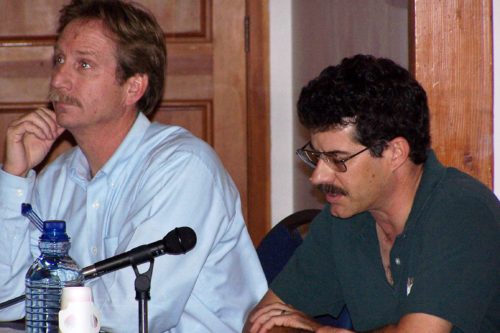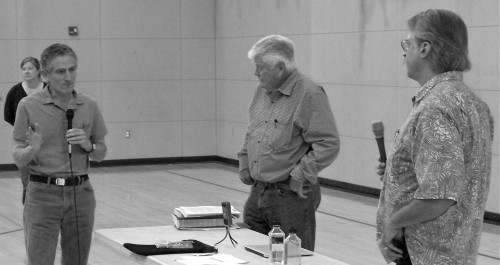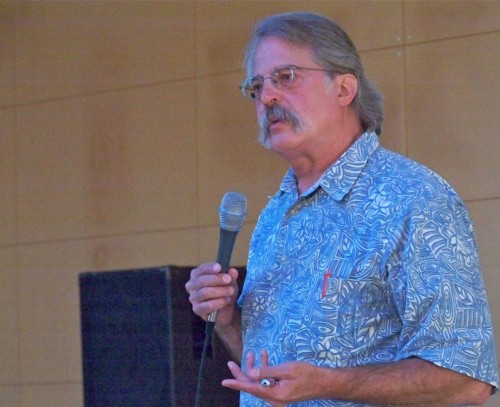Entries tagged with “Point Reyes National Seashore”.
Did you find what you wanted?
Sun 2 Oct 2016
During the 15 years Don Neubacher was superintendent of the Point Reyes National Seashore, he behaved deceptively on a number of occasions. Nonetheless, in 2010, he was made superintendent of Yosemite National Park.
It was a dramatic, albeit absurd, promotion. After he’d been on the job in Yosemite for six years, the Park Service in response to employee complaints conducted an investigation last August and concluded that Neubacher had created a work environment that was “toxic” for many staffers.

National Seashore Supt. Don Neubacher (left) at a 2004 town meeting in Point Reyes Station.
Besides the August investigation, 18 Yosemite Park employees a week ago informed the Oversight and Government Reform Committee of the House of Representatives that Neubacher had bullied, intimidated, and humiliated staff who complained of misconduct by him and other Park Service personnel.
“In Yosemite Park today, dozens of people, the majority of whom are women, are being bullied, belittled, disenfranchised and marginalized,” Yosemite fire chief Kelly Martin told the committee in written testimony concerning several parks.
During last week’s hearing, committee chairman Jason Chaffetz (R-Utah) quoted an Interior Department investigator at Yosemite as reporting, “The number of employees interviewed about the horrific working conditions leads us to believe that the environment is toxic, hostile, repressive, and harassing.”
The congressman added, “It is our understanding that of the 21 people the investigators interviewed, every single one of them, with one exception, described Yosemite as a hostile work environment as a result of the behavior and conduct of the park superintendent.”The one person who did not agree, Congressman Chaffetz wryly noted, was Supt. Neubacher.
Making matters worse, committee members said, was the fact that Neubacher’s wife Patty has been deputy director of the Park Service’s Pacific West Region, which oversees Yosemite.
But the jig is up, and last Thursday Supt. Neubacher acknowledged in an email to park employees that regional administrators had decided Yosemite needs new leadership. He had been offered an advisory job in Denver but had decided to retire from the Park Service effective Nov. 1. On Sunday, Patty Neubacher announced that she too was retiring as of Nov. 1.
Supt. Neubacher didn’t acknowledge actually doing anything wrong at Yosemite, only that he might have been insensitive. Writing to park staff he claimed, “Until recently I wasn’t aware of these concerns and am deeply saddened by this.
“It was never my intention in any way to offend any employee. If I did offend any of you at any time, I want to sincerely apologize.”
He didn’t intend to harass and belittle staff, female staff in particular? It was all a misunderstanding? Just how sincere is this apology?
 The crowd of townspeople who heard Don Neubacher (upper right) prevaricate about his own actions after the pepper spray incident in 2004.
The crowd of townspeople who heard Don Neubacher (upper right) prevaricate about his own actions after the pepper spray incident in 2004.
That kind of dissembling was on display all too often during Neubacher’s 15 years on Point Reyes. Many examples could be recounted. Here are just a couple: In July 2004, an emotionally out-of-control Point Reyes National Seashore ranger accompanied by a second ranger aggressively pepper-sprayed a teenage brother and sister while in Point Reyes Station. The attack was so savage that in order to spray directly onto the eyeballs of the girl, who was crouched on the pavement in handcuffs, the ranger held her eyelids apart.
The siblings’ only crime was to show up to ask why two friends of theirs had been taken into custody by rangers outside the park. The friends, by the way, were never charged with any misdeed.
The pepper-spraying created a public outcry, and a town meeting was held in Point Reyes Station so people could question park officials about it. To mollify the crowd, Neubacher told them he had asked the Park Service to conduct an internal investigation into the rangers’ behavior. And to allay any suspicion that an internal investigation might be biased, Neubacher added, he’d asked the Marin County District Attorney’s Office to conduct a “parallel” investigation.
The next day after the now-calmed crowd had gone home, a perplexed assistant DA remonstrated that the park superintendent had done no such thing. Neubacher hadn’t asked the DA’s Office to investigate the rangers; he had asked it to prosecute the brother and sister. Many townspeople who had been taken in by Neubacher’s fabrication were furious. In any case, the DA refused to prosecute the teenagers, and in September 2005 the Park Service paid them $50,000 to settle claims growing out of the incident.
In 2007, Neubacher began pushing a proposal to shut down Drakes Bay Oyster Company. Regardless of what you thought of the idea, there was no denying that Neubacher outright lied to the Marin County Board of Supervisors in arguing for it.
When the supervisors held a hearing to express support for the oyster company, Supt. Neubacher showed up to claim the oyster operation was bothering harbor seals. Neubacher had previously asked the US Marine Mammal Commission to look into this allegation, but earlier that same day, commission staff had faxed him that so far there had been no decision to do so.
Nonetheless, Neubacher told county supervisors, “The Marine Mammal Commission wrote us a letter this morning. They’re going to take it up on a national level.”
When an investigator from the Inspector General’s Office of the Interior Department later asked the park superintendent about his deception, “Neubacher conceded that it might have been a little bit misleading for him to say that the Marine Mammal Commission was taking up the issue and had written the National Park Service a letter,” the investigator reported.
What will Neubacher do now? Given his repeated fabrications while administering the Point Reyes National Seashore and his misogynistic style of management while administering Yosemite National Park, there may be a job waiting for him out there, working for Donald Trump.
Tue 10 Jul 2012
Drakes Bay Oyster Company owner Kevin Lunny headed to Irvine, Orange County, Tuesday to speak before the National Academy of Sciences, which is reviewing a Park Service environmental report on his operation.
He left with the understanding he would receive only three minutes to present his case for continuing to do business in the Point Reyes National Seashore after his present permit expires Nov. 30. When he got to the NAS meeting, however, Lunny received about half an hour to answer questions.

Drakes Bay Oyster Company owner Kevin Lunny.
This wasn’t supposed to be happening. Lunny bought the business from its former owner, Tom Johnson, seven years ago. At that time, Lunny and his lawyer negotiated a “statement of principle” with Interior Department attorneys and Jon Jarvis, then Pacific West Regional Director of the Park Service.
The agreement signed by both Jarvis and Lunny guaranteed the oyster grower that he would have plenty of input if an environmental-impact statement were required when the permit was up for renewal. Nonetheless, when the Park Service began preparing an EIS a year and a half ago, Lunny found himself excluded from the scoping process.
He brought up the legal document he and Jarvis (now national director of the Park Service) had signed only to have the Park Service tell him it was “unenforceable,” he noted this week. “If you don’t like it,” the Park Service added, “take it to court.” It was not the first time the Park Service had used that tactic.
Six years ago, former National Seashore Supt. Don Neubacher began a campaign of falsehoods, later exposed by the Inspector General of the Interior Department, among others, regarding the oyster operation in an effort to create opposition to renewing its permit. Lunny at the time reported that when he objected to the way he was being treated by the park, Neubacher’s response was, “You’ve got to remember, I don’t have to pay my lawyers.”

Retail sales building at Drakes Bay Oyster Company.
Neubacher’s political reason, aside from what turned into personal antipathy, for wanting Lunny to shut down operations in Drakes Estero is that Congress in 1976 had declared the surrounding area “potential wilderness.” The park, however, has chosen to ignore the congressional testimony of the legislation’s sponsors who said the proposed potential-wilderness designation would not affect oyster growing in the estero.
Although the Park Service has made no secret of being ready to ruin Lunny with legal bills if he stands on his rights, the stratagem hasn’t worked so far. Already, he has received “over $1 million worth of pro bono legal help” from one law firm, and two others are also joining in, Lunny said.
“The San Francisco Bay Area,” the oysterman explained, is “a tight-knit community, and people have been good to us. All are liberal Democrats, green-minded people, non-corporate. They care about honesty in government.” The unpaid legal representation could prove invaluable to Lunny should he need to legally challenge an adverse decision by the Park Service on his permit.
The Park Service has put forth various claims, each debunked in succession, that oyster growing in the estuary is bad for the environment. In contrast, an earlier National Academy of Sciences review found that oyster cultivation is not causing significant environmental problems and may well be benefiting the estero’s ecosystem.
The estuary used to be rich in native, Olympia oysters, but they were harvested to virtual extinction by the 1950s and 60s. The former oyster-company owners, the Johnson family, then began raising Pacific oysters, which have restored the ecosystem, the first Academy of Sciences review noted. Oysters are filter feeders that clean the water.
The Park Service in response has claimed there never were native oysters in the estero despite millions of Olympia oyster shells found in the middens (shell heaps) of Native Americans who lived beside the estuary.
Carbon dating has now determined the shells in the middens are prehistoric, prompting the Park Service to claim, without evidence, that Native Americans must have caught these millions of oysters in Tomales Bay and for unknown reasons hauled them all the way to Drakes Bay to eat them. To Lunny, the scenario seems ridiculous.
Larvae for today’s Pacific oysters, which are the variety grown on the West Coast, come from “carefully controlled” hatcheries in Oregon and Washington, Lunny said.
 Growing oyster larvae into seed oysters (Photo by Janine Warner).
Growing oyster larvae into seed oysters (Photo by Janine Warner).
He raises the larvae in tanks until they are large enough to attach themselves to old shells and then start growing their own shells. Only when these “seed oysters” are large enough not to fall through mesh growing bags are they hung from racks in the estero. In other cases, shells holding the seed oysters are hung in a line from the racks.
In response to EIR-related questions from the Park Service, Lunny on July 5 wrote to National Seashore Supt. Cecily Muldoon:
“Approximately 40 percent of Drakes Bay Oyster Company income is from onsite retail sales, 40 percent is sold directly to local markets and restaurants, all delivered by DBOC directly, 18 percent is sold to Tomales Bay shellfish growers, and 2 percent is sold through a wholesale seafood distributor based in San Francisco.”
 Oysters from racks in Drakes Estero are unloaded from a barge at the oyster company’s onshore site.
Oysters from racks in Drakes Estero are unloaded from a barge at the oyster company’s onshore site.
“In a very good year, DBOC might produce 850,000 pounds of oysters,” Lunny wrote. Those numbers would suggest that if the full 18 percent of DBOC’s total production in a very good year were to go to to Hog Island and Tomales Bay oyster companies, the total would be a whopping 153,000 pounds.
“The Tomales Bay growers have a huge demand they can’t meet,” Lunny said Monday. If Drakes Bay Oyster Company were shut down by the park, the effect on Tomales Bay growers would be significant, and those growers have supported DBOC’s efforts to renew its permit.
“We like to work with neighbors and colleagues,” Lunny said, and want the oysters sold locally to “come from locals.”
Washing freshly harvested oysters.
Nor is there any opportunity for Drakes Bay Oyster Company to relocate to Tomales Bay.
In his July 5 letter to Seashore Supt. Muldoon, Lunny wrote: “It is important to note that in late 2008 through early 2009, the National Park Service (NPS) seriously misled the public by telling US Senator Dianne Feinstein, the DBOC, and the public that NPS had a plan and an offer to relocate DBOC to Tomales Bay.
“In fact, NPS did not consult with the California Department of Fish and Game (CDFG) prior to making this assertion and did not have a plan to relocate DBOC.
“After NPS made the claim that it had a plan to relocate DBOC to Tomales Bay, NPS was informed by CDFG that this relocation was impossible for several reasons:
“NPS has no authority over the Fish and Game Commission (FGC) and CDFG leases and has no say over how shellfish leases are issued by the FGC.
“Tomales Bay shellfish production is already maximized to the extent practicable.
“There were no available leases in Tomales Bay to relocate DBOC.
“DBOC, in good faith, participated in discussions, committed to negotiations, and was willing to evaluate a proposal. It was only later that it became clear that the NPS did not have a relocation plan or proposal when it told Senator Feinstein and DBOC that it did. The NPS promised a relocation that was impossible.
“Nevertheless, the public remains misinformed about this relocation proposal. Members of the public known to be working closely with NPS staff continuously criticize DBOC for failing to negotiate with NPS regarding relocation.
“NPS has certainly heard these misrepresentations from the NPS supporters yet NPS has failed to correct the public record.”
A check on Tuesday with Kirsten Ramey, who is in charge of marine aquaculture for Fish and Game, found that while it technically might be possible to get a new shellfish-growing lease in Tomales Bay, in practical terms, it could not be done. The permits and studies necessary would be overwhelming.
Among the agencies that would have to study the proposal and approve it, she said, would be state Fish and Game, the County of Marin, the California Coastal Commission, the Regional Water Quality Control Board, the Army Corps of Engineers, the Coast Guard and possibly others. Virtually no one can afford the cost, which is why no new leases have been issued for years, she explained.
Lunny had not received a response to his letter to Supt. Muldoon before his trip to Irvine Tuesday, but DBOC critic Gordon Bennett had read it thanks to the park’s having quietly posted the letter online.
Ramey noted that Bennett, citing the letter, had called her asking about oysters from Drakes Estero being sold at Tomales Bay. His apparent concern, she said, was that organisms or pathogens could be transferred from one bay to the other this way.
However, that is not possible, Ramey said, because Hog Island and Tomales Bay oyster companies sell the DBOC oysters from tanks and do not place them in their bay. Tank water is not discharged into the bay, she added.
By now, Lunny’s fight to get his oyster company’s permit renewed has gone on for years, and if the dispute ultimately lands in court, the fight could go on a good deal longer.
Mon 2 Apr 2012
Posted by DavidMitchell under General News, Point Reyes National Seashore
Comments Off on Senator Feinstein says Park Service employees ‘feel emboldened to once again fabricate science’
In attempting to justify not renewing in September Drakes Bay Oyster Company’s permit to operate in the Point Reyes National Seashore, park staff falsified scientific data. Fortunately, the Inspector General’s Office of the Interior Department uncovered many of the misrepresentations by National Seashore staff, and in 2008 it issued a report that chronicled them.
 Yet Park Service employees are doing it again, as US Senator Dianne Feinstein (D-CA) complained to Interior Secretary Ken Salazar (right) last Thursday.
Yet Park Service employees are doing it again, as US Senator Dianne Feinstein (D-CA) complained to Interior Secretary Ken Salazar (right) last Thursday.
This is the senator’s letter to the Interior Department, which administers the Park Service:
Dear Secretary Salazar,
The Park Service’s latest falsification of science at Point Reyes National Seashore is the straw that breaks the camel’s back.
The Park Service presented charts of noise measurements in its draft environmental impact statement (DEIS) that appear to irrefutably establish that oyster boats at Drakes Bay disturb the pastoral quiet of the nearby wilderness.
Here is the problem: the noise did not come from oyster boats, nor did it come from anywhere near Drakes Estero or Point Reyes National Seashore. Amazingly, the decibel recordings the Park Service attributed to Drakes Bay oyster boats came from jet skis in New Jersey 17 years ago.
 Entrance and picnic area for Drakes Bay Oyster Company.
Entrance and picnic area for Drakes Bay Oyster Company.
I am frankly stunned that after all the controversy over past abuse of science on this issue, Park Service employees would feel emboldened to once again fabricate the science in building a case against the oyster farm. I can only attribute this conduct to an unwavering bias against the oyster farm and historic ranches.
My attention was drawn to the Seashore when I fought to extend local ranching leases from five to 10 years so there would be sufficient investment and time for the farmers and ranchers to not only operate viable businesses, but to perform environmental improvements. Despite efforts to comply, the ranches and oyster farm have been subject to repeated mistreatment that is unbecoming of your department.
 The Park Service has falsified and misrepresented data, hidden science, and even promoted employees who knew about the falsehoods, all in an effort to advance a predetermined outcome against the oyster farm. Using 17-year-old data from New Jersey jet skis as documentation of noise from oyster boat engines in the estuary is incomprehensible.
The Park Service has falsified and misrepresented data, hidden science, and even promoted employees who knew about the falsehoods, all in an effort to advance a predetermined outcome against the oyster farm. Using 17-year-old data from New Jersey jet skis as documentation of noise from oyster boat engines in the estuary is incomprehensible.
It is my belief that the case against Drakes Bay Oyster Company is deceptive and potentially fraudulent.
Senator Feinstein at left.
The Park Service’s conduct is a serious breach of trust with the farming and ranching community at Point Reyes National Seashore. The ranchers are concerned that if Drakes Bay Oyster Company’s permit is not renewed, they will be next. I share that concern.
I firmly believe that renewal of the permit is the only way for the Park Service to send an unmistakeable signal that the Administration’s commitment to scientific integrity is real and that repeated misrepresentations of the scientific record to advance employees’ personal agendas will not be tolerated. I also believe that renewal of the permit is the only way for the Park Service to begin to repair the trust of the Seashore’s ranching and farming community.
I look to you to bring resolution to this very serious matter.
Sincerely, Dianne Feinstein, United States Senator
Wed 14 Mar 2012
Once in awhile, I let others use this space to address issues of particular concern to them. This week’s contributor is Dr. Corey Goodman of Marshall, a member of the National Academy of Sciences. Corey was the first to reveal that the Point Reyes National Seashore administration was using bogus data in trying to build a case for kicking Drakes Bay Oyster Company out of the park.
Now he has revealed more Park Service shenanigans in its handling of public comments on an environmental-impact statement about whether the oyster company should be allowed to stay in the park.
“Oh what a tangled web we weave when first we practice to deceive.” Sir Walter Scott
By Dr. Corey Goodman
The National Environmental Policy Act (NEPA) got turned on its head recently when the National Park Service released a partial analysis of the public comments received in response to the draft Environmental Impact Statement concerning the fate of the oyster farm in Point Reyes National Seashore.
The Citizen’s Guide to NEPA, published by the Council on Environmental Quality (part of the White House), wrote: “It is important to understand that commenting on a proposal is not a ‘vote’ on whether the proposed action should take place.” Dr. John Felleman, a NEPA scholar at State University of New York, wrote concerning the intent of the public comment period: “The intent is to assess the adequacy of the data, alternatives, and analyses, not to have an opinion poll.”
Nevertheless, the park triggered just such an opinion poll. In an action that appears to be unprecedented, the park released a partial “preliminary content analysis report” of the National Park Service’s draft environmental impact statement, telling the community that there were more than 52,000 public comments, and that more than 47,000 of them were for Alternative A, i.e., elimination of the oyster farm.
Although the park analysis contained lots of numbers about the geography and origins of the comments, what was conspicuously absent was what is most obvious when one first examines them, more than 90 percent of the comments are duplicate form letters (sent by email).
No surprise, within minutes of the Park press release, Neal Desai of the National Parks Conservation Association and Amy Trainer of the Environmental Action Committee of West Marin concluded, based upon Park Service analysis, that 92 percent of the public comments favored eliminating the oyster farm from Point Reyes, and proclaimed that “the people have spoken.”
A week later, on March 9, 2012, the Marin IJ published an editorial on the 52,000 public comments, and wrote: “Both sides in this battle have well-funded advocacy groups that can generate letters, postcards and e-mails in support of their cause.” Given the intervening week, it is too bad the Marin IJ didn’t dig a bit deeper into the origin of those comments to determine how they were generated, and thus how the public was spun by NPS and its supporters.
Last week, The Point Reyes Light and The West Marin Citizen newspapers reported, based on analysis from Sarah Rolph and me, that 86 percent of those comments were duplicate emails generated by mass emails from four environmental organizations: Sierra Club, Natural Resources Defense Council (NRDC), the National Parks Conservation Association (NPCA), and the National Wildlife Foundation (NWF).
These groups’ emails misinformed people, falsely claiming environmental harm where no such data exists, and asked the recipients to click “over and over again,” to send pre-written messages that advocated evicting the oyster farm.
The Park Service released those biased numbers completely unfiltered. Such behavior was contrary to NEPA guidance and irresponsible of the Park Service and the NGOs.
Reporting that 86 percent of 52,000 comments were click-and-send form letters was an under-estimate. Further computer analysis revealed another 2,445 comments (5 percent) were fragments of form letters. The total based upon form letters was thus nearly 91 percent
Desai of NPCA correctly pointed out that pro-oyster farm supporters also submitted several hundred form letters, but these amounted to fewer than 1 percent vs. his side’s 91 percent. These numbers are a wee bit more one-sided than the Marin IJ editorial led readers to think when it stated both sides “have well-funded advocacy groups that can generate letters.”
 The spikes in the graph correspond to the days that four groups sent out mass emails that asked recipients to click on a button which would send an email to the Park Service urging it to get rid of the oyster company. The responses came from throughout the United States although according to National Seashore figures, 70 percent of the two million people who visit the park annually come from the nine-county Bay Area. That would suggest that most of the emails came from people who had no direct knowledge of the oyster farm.
The spikes in the graph correspond to the days that four groups sent out mass emails that asked recipients to click on a button which would send an email to the Park Service urging it to get rid of the oyster company. The responses came from throughout the United States although according to National Seashore figures, 70 percent of the two million people who visit the park annually come from the nine-county Bay Area. That would suggest that most of the emails came from people who had no direct knowledge of the oyster farm.
If all duplicate form letters are eliminated, from all sides, less than 5,000 comments remain, of which many are duplicates. For example, Rick Johnson, an NPS supporter, was counted nine times. Nevertheless, if those 5,000 comments are surveyed, over 80 percent support renewing the oyster farm lease while less than 20 percent support eliminating it.
That is a far cry from the 92 percent for eliminating the farm announced by Trainer of the EAC and Desai. Perhaps the people have spoken, just not in the way Trainer and Desai misled the community to believe.
A challenge to the park: do a better analysis. Since the park has already turned NEPA on its head by releasing a partial analysis, let’s encourage them to at least do the right analysis. Release another count without form letters, or form letter fragments, from both sides. Count only original letters; count each person once.
If the majority favors renewal of the lease, as our analysis shows, then you and your supporters owe the community the truth and an apology for misleading us.
Mon 13 Feb 2012
Posted by DavidMitchell under General News
[2] Comments
 Drake’s Bay Oyster Company and its predecessors have operated within Drakes Estero for a century.
Drake’s Bay Oyster Company and its predecessors have operated within Drakes Estero for a century.
 The scientific misconduct of former Point Reyes National Seashore Supt. Don Neubacher (right), misrepresenting park research to try to force Drakes Bay Oyster Company out of the park, has now become a political problem for the Obama administration.
The scientific misconduct of former Point Reyes National Seashore Supt. Don Neubacher (right), misrepresenting park research to try to force Drakes Bay Oyster Company out of the park, has now become a political problem for the Obama administration.
Nebaucher’s misconduct was covered up by Jon Jarvis, then director of the Pacific West Region of the Park Service and now the Park Service director.
Especially in this election year, Republicans are looking for ways to take pokes at President Obama, and the White House’s 2009 nomination of Jarvis to be director of the Park Service has provided them with an opportunity.
Senator Dianne Feinstein (D-Ca.) had previously excoriated the Park Service’s behavior. Now two conservative senators, David Vitter (R-La.) and Senator James Inhofe (R-Ok.), ranking member of the Senate Committee on Environment and Public Works, have taken up the cause, claiming it epitomizes failings by the White House and its Interior Department.
Dr. Corey Goodman of Marshall, an elected member of the National Academy of Sciences, first brought to light the National Seashore administration’s misrepresentations, which have resulted in this political brouhaha.
In a letter sent today to Interior Department Secretary Ken Salazar, Senators Vitter and Inhofe wrote:
“As we continue to investigate issues related to scientific misconduct at our federal agencies, it has been brought to our attention a concerning matter related to Jon Jarvis, director of the National Park Service (NPS).
“Of particular interest to our efforts are the circumstances involving a distinguished member of the National Academy of Sciences (NAS), White House science advisor Dr. John Holdren, and the serious concerns of Senator Dianne Feinstein.
 “On three occasions in 2009, while the Jarvis (left) nomination was being vetted, Dr. Corey Goodman, an elected NAS member, submitted three letters to you detailing a case of serial scientific misconduct by Jon Jarvis and National Park Service (NPS) officials and scientists under his direct supervision.
“On three occasions in 2009, while the Jarvis (left) nomination was being vetted, Dr. Corey Goodman, an elected NAS member, submitted three letters to you detailing a case of serial scientific misconduct by Jon Jarvis and National Park Service (NPS) officials and scientists under his direct supervision.
“It is our understanding that Dr. Goodman contacted you after discussing the matter concerning Jon Jarvis, Drakes Bay Oyster Company, and Point Reyes National Seashore with Dr. (John) Holdren, science advisor to the president.
“We are in possession of the three letters dated April 27, 2009, May 10, 2009, and May 16, 2009. That a distinguished member of the NAS would need to send such letters of concern to you directly is distressing. Even more distressing is the fact you that you have failed to respond.
“Dr. Goodman’s three letters outline significant matters of scientific integrity that in the light of President Obama’s promise of ‘restoring science to its rightful place’ logically would have necessitated your response and responsible steps to rectify Jarvis’ work.
“At a minimum, all of these should have been disclosed during Jarvis’ nomination process to the White House, Senate Energy Committee and the Congress, and all should have been made aware of the ongoing investigations into the the work of then-Regional Director of the Pacific West Region Jarvis.
“We are also aware that you asked Mr. Jarvis to respond to Dr. Goodman’s 21 points outlined in his May 16, 2009, letter to you, but that Mr. Jarvis responded to only seven of those points on May 17, 2009.
 “At Dr. Holdren’s request, Dr. Goodman (who plays jazz in his spare time, left) provided a critical review of Jarvis’ partial response on May 19, 2009.
“At Dr. Holdren’s request, Dr. Goodman (who plays jazz in his spare time, left) provided a critical review of Jarvis’ partial response on May 19, 2009.
“Did Congress have copies of Dr. Goodman’s three letters, the Jon Jarvis response, and Dr. Goodman’s critique of that response during the nomination process? If not, why was this information withheld?
“As Senator Feinstein recently noted, ‘Three independent offices, the Interior Department’s Inspector General, the National Academy of Sciences, and the Interior solicitor, uncovered errors and misrepresentations in the National Park Service’s assessment of oyster farm operations.’
“Our question, of course, then would be: If the NAS, the Interior IG, and DOI [Department of the Interior] Solicitor properly disclosed the totality and scope of pending scientific integrity issues, and then fully disclosed his conduct to the White House and the President, would (a) Mr. Jarvis’ name even have been recommended by you to the President; and (b) the President have submitted the nomination to the US Senate for confirmation?
“Over the last several years we have uncovered multiple instances of scientific misconduct at the EPA and Interior. Last year, we noted some of those in a letter to Dr. Holdren. Unfortunately, Dr. Holdren flouted congressional oversight and implicitly admitted in his response that he had not taken any steps to address these very real and serious concerns.
“We are hopeful that you have not taken a similar ‘pass’ on issues of scientific integrity. Accordingly, we ask for thorough and complete responses to the following:
“1. What is the status of Interior’s response to the three letters by Dr. Goodman’s critique of Jarvis’ partial response?
“2. Who at Interior was charged with responding to the three letters written by Dr. Goodman? Please provide all emails, memorandum or other documents related to each of Dr. Goodman’s three letters.
“3. Upon receipt of Dr. Goodman’s complaint, did you as Secretary direct that an investigation be initiated to determine whether or not the Data Quality Act, White House STP [Science and Technology Policy] on Research Misconduct, or the NPS Code of Scientific and Scholarly Misconduct were violated? If not, why not?
“4. Did you disclose to the White House, when the Jarvis nomination was being vetted, that three letters and 21 counts of scientific misconduct against Jarvis were pending? Did you or anyone else at the Department of the Interior similarly disclose these developments to the US Senate?
“Please provide the report(s), letters, memorandum, emails and/or documents which disclosed these circumstances to either the White House and/or the US Senate during consideration of the nomination or during the confirmation process. If any information was withheld, who at Interior or the White House determined that the information related to Mr. Jarvis’ conduct did not need to be brought to the the attention of the Senate during his confirmation?

Kevin Lunny, owner of Drakes Bay Oyster Company.
“5. What is the status of the permits for Drakes Bay Oyster Company?
“6. Did Mr. Jarvis disclose that in December 2007, a 77-page integrity complaint had been submitted to the Director, National Park Service and never answered?
“What is the status of the outstanding ethics complaint against Jon Jarvis and Don Neubacher submitted to [former NPS] Director [Mary A.] Bomar on Dec 18, 2007, and did the US Department of the Interior and/or the National Park Service investigate those scientific misconduct allegations?
“7. The third of three Goodman letters detailed 21 counts of scientific misconduct by Mr. Jarvis. Immediately upon receipt, according to available information, Mr. Jarvis provided you with responses to seven of the 21 counts and did not even address the majority of the charges. Please provide detailed responses to each of these specific charges.
“Why was Mr. Jarvis allowed to provide only a partial response? Why did you fail to respond to Dr. Goodman? Were Jarvis’ responses provided to the White House and/or Senate Committee on Energy and Natural Resources?
“Please attest to the veracity of each of the 21 points outlined in the May 16, 2009, letter from Dr. Goodman. Which of the points did Jon Jarvis respond to and which did he exclude? In light of Dr. Goodman’s critique of Jarvis’ partial response, do you consider the Jarvis response adequate?
“We concur with Senator Feinstein that ‘the transparency that comes with scientific review is a good thing, even when it doesn’t support an individual’s agenda.’ It remains imperative that individual agendas of federal bureaucrats lacking a scientific basis are not allowed to undermine private citizens and our economy.
“If nobody has yet been charged with responding to Dr. Goodman’s letters, we ask that you personally respond and that we receive copies of those responses. It is particularly troubling that Jarvis was accused of being involved in and directing a cover-up of the fabrication, falsification and/or misrepresentations of scientific misconduct.
“It is further frustrating that you were informed of these significant matters and it appears that nothing was done.
“It does our nation and science a disservice to allow any agency of the federal government to ignore the responsibility to investigate scientific misconduct, especially when brought to your direct attention.”
In addition to their letter to Interior Secretary Salazar, the senators also made public comments:
 Senator Vitter (right): “We’ve seen facts manipulated and science ignored across the administration while they’ve developed policies with huge negative effects on the economy.
Senator Vitter (right): “We’ve seen facts manipulated and science ignored across the administration while they’ve developed policies with huge negative effects on the economy.
“We want the public to be aware of the administration’s scientific gimmickry, because important policy decisions by the EPA and Interior shouldn’t be based on guesswork or manipulated facts.
And we want the agencies to be transparent and explain their methods.”
 Senator Inhofe (left): “It is extremely troubling that 21 counts of scientific misconduct by Mr. Jarvis were either ignored or only partially addressed by Secretary Salazar, especially as Mr. Jarvis was being considered for a key post within the Department of the Interior.
Senator Inhofe (left): “It is extremely troubling that 21 counts of scientific misconduct by Mr. Jarvis were either ignored or only partially addressed by Secretary Salazar, especially as Mr. Jarvis was being considered for a key post within the Department of the Interior.
However, given the numerous examples of the Obama Administration using dubious science to bolster their agenda, I am not surprised. Senator Vitter and I will continue to pursue this case, as well as the many other instances of scientific misconduct with the Obama Department of the Interior and EPA, until we have answers.”
Both Vitter and Inhofe are friendly to the Tea Party and skeptical of scientists who say humans are contributing to climate change. By misrepresenting scientific research, Jarvis and Neubacher ended up playing right into the senators’ hands.
Tue 1 Nov 2011
Posted by DavidMitchell under General News, History, Inverness, Marin County, Point Reyes Station
Comments Off on Symposium on National Seashore misdeeds; pancake fundraiser for firefighters & Disaster Council; barn dance; all in Pt. Reyes Station

Dr. Corey Goodman of Marshall (left), who uncovered the National Park Service’s using bogus data to discredit Drakes Bay Oyster Company (owned by the Lunny family of Inverness), questions Pete McCloskey, a retired congressman (center), and Paul Berkowitz, a retired ranger and criminal investigator for the Park Service. Behind them and serving as moderator was Laura Watt, an assistant professor of Environmental Studies at Sonoma State.
During a symposium Sunday afternoon in the West Marin School gym, McCloskey and Berkowitz discussed “corruption” at the top levels of the National Park Service (NPS). Low-level rangers, they agreed, were more likely to be honest.
Berkowitz, who for 33 years was a ranger and criminal investigator for NPS, has written a book, The Case of the Indian Trader, which focuses on a particularly egregious example of corruption that occurred at the Hubbell Trading post on a Navajo reservation in Arizona. The book, however, also describes many other cases of criminal behavior by NPS staff, such as child molesting, theft of government funds, and shredding crime reports on people in NPS’s favor.

More than 115 West Marin residents showed up for the symposium, forcing organizers to put out extra chairs.
McCloskey, who spent 15 years in the House of Representatives, noted that the House Committee on Oversight and Government Reform, which is chaired by Darrell Issa (R-San Diego County), will begin an investigation on Nov. 7 of Point Reyes National Seashore officials. “The alleged misconduct is serious and could result in the loss of the Lunny family’s business,” Issa wrote Interior Department Secretary Ken Salazar. “Time is of the essence, as the family’s reservation of use expires next year.
“In light of a damaging draft Environmental Impact Statement released on Sept. 3, 2011, it is imperative that a thorough, objective review of whether NPS’s conclusions are based on flawed science occurs immediately.”
Among those summoned to testify before the committee are: Gavin Frost of the Solicitor’s Office (he has already turned up skulduggery within the Nation Seashore administration); Don Neubacher (former superintendent of the park); Jon Jarvis (NPS director, as well as the previous director of the Pacific West Region of NPS); Dr. Marcia McNutt (adviser to the NPS; Sarah Allen (former science adviser to the National Seashore); Dr. Ben Becker (NPS scientist); and Cicely Muldoon (current superintendent of the National Seashore).
McCloskey, 84, had been a colonel in the Marine Corps and was awarded the Navy Cross, the Silver Star and two Purple Hearts for outstanding service during the Korean War. The former congressman had also been a lawyer in Redwood City, a deputy district attorney in Alameda County, and a lecturer on legal ethics at the Stanford and Santa Clara law schools. He warned that any NPS official who doesn’t testify with total honestly will be charged with perjury.

Berkowtz had taken over an NPS investigation that had been triggered by Western National Parks Association allegations against Billy Malone, who operated Hubbell Trading Post. The allegations were based only on faulty intuition, but WNPA wanted Berkowtz to find something, anything, for which the trader could be prosecuted.
Berkowitz instead found that the NPS was hiding exculpatory evidence, had lied to get a search warrant, and then had seized much of Malone’s private property although the warrant did not provide for this. The case had been going on for a few years and had become expensive. WNPA, which was well over $1 million in debt, hoped to sell Malone’s personal property to pay off its debts.
The investigator said the Army’s cavalry originally kept order in national parks, which explains rangers’ uniforms. In 1916, however, the Park Service was created as a “civilian version of the military. It was disciplined, regimented, and had a rigid application of standards.” Over time, however, the Park Service abandoned critical components of military conduct, so that there’s now “an enormous variance of management competence.”
In 1976, the law that established the Park Service was strengthened, Berkowitz said, giving NPS authority to investigate all federal-law violations in national parks. He concluded by saying he loves national parks and would never want to harm them. However, he added, NPS leaders’ corruption must be stopped.

The annual pancake breakfast was held Sunday morning in the Point Reyes Station firehouse. The event is always a fundraiser for the West Marin Disaster Council and the Inverness Volunteer Fire Department.
 Having fun at the pancake breakfast was Rich Clarke of Marshall, a member of the West Marin Disaster Council.
Having fun at the pancake breakfast was Rich Clarke of Marshall, a member of the West Marin Disaster Council.

Approximately 325 people attended the pancake breakfast, and a firefighter told me the crowd was the largest in years. He credited sunny weather for bringing out so many West Marin residents.

West Marin Commons sponsored a Halloween barn dance in Toby’s Feed Barn Friday evening. Band members (from left): Brian Lamoreaux on guitar, Sue Walters on bass, Ingrid Noyes on accordion, and Erik Hoffman on fiddle. Because the feed barn is unheated and the band sits next to an open door, there will be no more barn dances this season. It’s becoming too cold for the musicians.
 However line dances, square dances, and even waltzes kept the dancers warm.
However line dances, square dances, and even waltzes kept the dancers warm.

Angel mother Denise Spenard of Marshall and devil daughter Maia, 8, had a jolly time wearing Halloween costumes to the barn dance.

 The crowd of townspeople who heard Don Neubacher (upper right) prevaricate about his own actions after the pepper spray incident in 2004.
The crowd of townspeople who heard Don Neubacher (upper right) prevaricate about his own actions after the pepper spray incident in 2004.
























